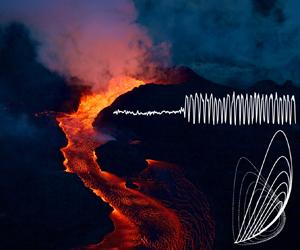No CrossRef data available.
Article contents
Pulsing in the Ahu‘ail $\bar{{\textbf{a}}}$‘au pond–spillway system during the 2018 K
$\bar{{\textbf{a}}}$‘au pond–spillway system during the 2018 K $\unicode{x012B}$lauea eruption: a dynamical systems perspective
$\unicode{x012B}$lauea eruption: a dynamical systems perspective
Published online by Cambridge University Press: 10 May 2024
Abstract

During the 2018 K $\unicode{x012B}$lauea lower East Rift Zone eruption, lava from 24 fissures inundated more than 8000 acres of land, destroying more than 700 structures over three months. Eruptive activity eventually focused at a single vent characterized by a continuously fed lava pond that was drained by a narrow spillway into a much wider, slower channelized flow. The spillway exhibited intervals of ‘pulsing’ behaviour in which the lava depth and velocity were observed to oscillate on time scales of several minutes. At the time, this was attributed to variations in vesiculation originating at depth. Here, we construct a toy fluid dynamical model of the pond–spillway system, and present an alternative hypothesis in which pulsing is generated at the surface, within this system. We posit that the appearance of pulsing is due to a supercritical Hopf bifurcation driven by an increase in the Reynolds number. Asymptotics for the limit cycle near the bifurcation point are derived with averaging methods and compare favourably with the cycle periodicity. Because oscillations in the pond were not observable directly due to the elevation of the cone rim and an obscuring volcanic plume, we model the observations using a spatially averaged Saint-Venant model of the spillway forced by the pond oscillator. The predicted spillway cycle periodicity and waveforms compare favourably with observations made during the eruption. The unusually well-documented nature of this eruption enables estimation of the viscosity of the erupting lava.
$\unicode{x012B}$lauea lower East Rift Zone eruption, lava from 24 fissures inundated more than 8000 acres of land, destroying more than 700 structures over three months. Eruptive activity eventually focused at a single vent characterized by a continuously fed lava pond that was drained by a narrow spillway into a much wider, slower channelized flow. The spillway exhibited intervals of ‘pulsing’ behaviour in which the lava depth and velocity were observed to oscillate on time scales of several minutes. At the time, this was attributed to variations in vesiculation originating at depth. Here, we construct a toy fluid dynamical model of the pond–spillway system, and present an alternative hypothesis in which pulsing is generated at the surface, within this system. We posit that the appearance of pulsing is due to a supercritical Hopf bifurcation driven by an increase in the Reynolds number. Asymptotics for the limit cycle near the bifurcation point are derived with averaging methods and compare favourably with the cycle periodicity. Because oscillations in the pond were not observable directly due to the elevation of the cone rim and an obscuring volcanic plume, we model the observations using a spatially averaged Saint-Venant model of the spillway forced by the pond oscillator. The predicted spillway cycle periodicity and waveforms compare favourably with observations made during the eruption. The unusually well-documented nature of this eruption enables estimation of the viscosity of the erupting lava.
Information
- Type
- JFM Papers
- Information
- Creative Commons
- To the extent this is a work of the US Government, it is not subject to copyright protection within the United States. Published by Cambridge University Press.
- Copyright
- © U.S. Geological Survey, 2024.


